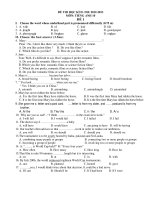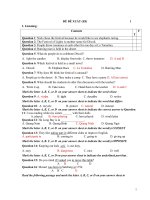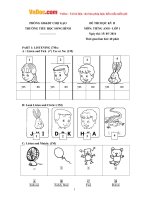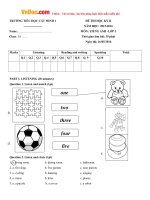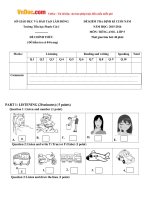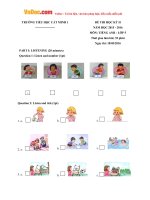- Trang chủ >>
- Đề thi >>
- Tuyển sinh lớp 10
ĐỀ THI HỌC KỲ 1 MÔN TIẾNG ANH 8 LỚP GLOBAL SUCCESS - ĐỀ SỐ 1 LOIGIAIHAY COM
Bạn đang xem bản rút gọn của tài liệu. Xem và tải ngay bản đầy đủ của tài liệu tại đây (665.12 KB, 19 trang )
<span class="text_page_counter">Trang 1</span><div class="page_container" data-page="1">
<i><b>Exercise 1. You will hear five short conversations. You will hear each conversation twice. There is one question for each conversation. For questions 1-5, choose the right answer. </b></i>
<b>1. What time will the taxi arrive at the woman’s house? </b>
<b>2. What will they give George? </b>
<b>3. Where will they sit? </b>
<b>4. What size does the woman buy? </b>
<b>5. Which ice cream will they have? </b>
<i><b>Exercise 2. Listen to a conversation and complete the table. </b></i>
<b>ĐỀ THI HỌC KÌ 1 – ĐỀ SỐ 1 </b>
<b>MÔN: TIẾNG ANH 8 GLOBAL SUCCESS </b>
<b> BIÊN SOẠN: BAN CHUYÊN MÔN LOIGIAIHAY.COM </b>
</div><span class="text_page_counter">Trang 2</span><div class="page_container" data-page="2"><b>Radio 33 Competition </b>
For students younger than: Date of competition: Place:
Starts at: First prize:
For information phone:
16
<b>(6)………..December (7) Town ……… (8)………..pm (9)……….ride (10) Maggie……… </b>
<i><b>Exercise 3. Find the word which has a different sound in the underlined part. </b></i>
<b>12. A. food B. tooth C. good D. smooth </b>
<i><b>Exercise 4. Circle A, B, C or D for each gap in the following sentences. </b></i>
<b>13. I always enjoy </b> <i><b> to my grandfather. He always tells me great stories. </b></i>
A. to talk B. to talking C. talking D. talk
<b>14. The Internet allows us to communicate ________friends from different parts of the world. </b>
A. to B. with C. for D. of
<b>15 ‘I was wondering if you’d like to go to Da Lat Flower Festival’ ‘- When does it take place?’ </b>
A. Not bad! B. Are you sure? C. For what? D. Sure, I’d love to!
<b>16. Red envelopes are believed to bring good _________ on Tet holiday. </b>
A. luck B. love C. wish D. hope
<b>17. Linh wanted to make some pies but didn’t have apples; _________, she decided to bake a cake. </b>
A. therefore B. in contrast C. namely D. so
<b>18. There’s a __________ of having parties at Christmas. </b>
A. habit B. rule C. tradition D. practice
<b>19. Mr. Ba: “Children in my village often fly their kites in dry rice fields.” Mrs. Black: “______________” </b>
A. It’s right up my street! B. That’s awesome.
<b>C. Exactly what I want. D. How interesting! 20. ethnic Khmer live in Mekong Delta of Vietnam. </b>
<i><b>Exercise 5. Read the passage. Circle the best answer A, B or C to fill in the blank. </b></i>
<b>The country is more beautiful than a town and (21) </b> to live in. Many people think so and go to the
<b>country for the summer holidays though they cannot live there all the year round. Some have a cottage (22) </b>
in a village so that they can go there whenever they have time.
<b>English villages are not all alike, but in some ways they are not different (23) </b> one another. Almost every village has a church, the round or square tower of which can be seen for many miles around. Surrounding the church is the churchyard, where people are buried.
</div><span class="text_page_counter">Trang 3</span><div class="page_container" data-page="3">The village green is a wide stretch of grass, and houses or cottages are built round it. Country life is now fairly
<b>(24) </b> and many villages have water brought through pipes into each house. Most villages are so
<b>(25) </b> some small towns that people can go there to buy what they can’t find in the village shop.
<b>21. A. please </b> B. pleased C. pleasure D. pleasant
<b>22. A. build </b> B. building C. built D. is built
<b>24. A. difficult </b> B. comfortable C. enjoyable D. improved
<b>25. A. far away </b> B. out of C. beyond D. close to
<i><b>Exercise 6. Read the passage. Circle the best answer A, B, C or D to each of the questions. </b></i>
The Tay live mainly in the Northeastern part of Viet Nam. They live in large and crowded villages with hundreds of houses. They live in houses built on stilts. They are mainly farmers, and they grow rice on terraced fields. They also raise cattles and poultry. Tay traditional dress is made from homegrown cotton. There is usually not much embroidery or other decorations. Women wear skirts or trousers, with short shirts inside and long one on the outside.
They have many festivals and holidays in a year. The Lunar New Year and the mid-July festivals are the most
<i>lavishly organized. During festivals, people in many places play con throwing, badminton, tug-of-war, dragon </i>
dancing, or chess.
<i>The Tay eat mainly sticky rice. On festival occasions, they make many kinds of cakes, such as banh chung (sticky rice square cakes), banh day (sticky rice round cakes) or banh khao (cakes made of white rice flour). </i>
<b>26. Which of the following best describes the main idea of the passage? </b>
A. The Tay live in the Northeastern part of Viet Nam. B. The life of the Tay in Viet Nam.
C. The Tay have many festivals and holidays in a year. D. How the Tay earn their living.
<b>27. What do the Tay mainly eat? </b>
A. sticky rice B. sticky rice and round cakes C. sticky rice and square cakes D. square cakes
<b>28. Which is NOT true of the Tay? </b>
A. They live in stilt houses. B. They grow rice on terraced fields. C. They wear clothes with much embroidery. D. They raise cattles and poultry.
<b>29. Which is TRUE of the Tay’s life? </b>
A. They mainly work in agriculture. B. They work in industry. C. They have one very important festival a year. D. They don’t eat sticky rice.
<b>30. The word "lavishly" is closest in meaning to ______. </b>
A. seriously B. carefully C. luxuriously D. happily
<i><b>Exercise 7. Rewrite second sentences with the same meaning. </b></i>
</div><span class="text_page_counter">Trang 4</span><div class="page_container" data-page="4"><b>31. Study hard and you will pass your exam. </b>
<b>35. A sports car goes faster than an ordinary one. </b>
→ An ordinary car goes ...
<i><b>Exercise 8. Give the correct form of the word in the rackets in the following questions. </b></i>
<b>36. Nga eats more _________ than Tung does because she likes fast food. (HEALTHY) </b>
<b>37. The ______ houses of many ethnic groups are used to worship the ancestors. (COMMUNE) 38. Most of the Central Highlands is __________. (MOUNTAIN) </b>
<b>39. Do villagers today dress _______ as in the past? (TRADITION) </b>
<b>40. I am _________ in her hometown with a lot of paddy fields. (INTEREST) ---THE END--- </b>
</div><span class="text_page_counter">Trang 5</span><div class="page_container" data-page="5">31. If you study hard, you will pass your exam.
32. Duong is keen on travelling and has been everywhere. 33. I can cook better than my mother.
34. Although he was tired, he did the test very well. 35. An ordinary car goes more slowly than a sports car.
<b>HƯỚNG DẪN GIẢI CHI TIẾT </b>
<b>Bài nghe: Part 1: </b>
<b>1. What time will the taxi arrive at the woman’s house? A: Tommy’s taxi company. </b>
<b>B: Hello. I need a taxi to go to the city airport tomorrow. My plane leaves at 07:30. </b>
<b>A: So you’ll need to be there at 06:30. I’ll send a car at 05:30. It usually takes about 45 minutes. B: Okay, my address is … </b>
<b>2. What will they give George? </b>
<b>A: George wants a bicycle for his birthday. But they’re so expensive. B: What about some videos or a guitar? He loves music. </b>
<b>A: I know, but he’s wanted one for a long time. B: Well, let’s get him what he wants then. 3. Where will they sit? </b>
<b>A: Do you want to sit under that tree, Granny? It won’t be so hot there. B: I’d prefer to sit in the sun. It looks nice there by the river. </b>
<b>A: Shall I put the chairs there then? </b>
<b>B: Yes, they’re in the car. Why don’t you go and get them? I’ll get the food ready. 4. What size does the woman buy? </b>
<b>A: Do you have another one of these pink T-shirts? </b>
</div><span class="text_page_counter">Trang 6</span><div class="page_container" data-page="6"><b>B: There’s this one. </b>
<b>A: But that’s a size 42. I need a smaller one. </b>
<b>B: Here’s a 40. The size 38 will be too small for you. A: Okay, thanks. </b>
<b>5. Which ice cream will they have? </b>
<b>A: That was a good meal. You are a good cook. </b>
<b>B: Are you full, or would you like some ice cream before your coffee? A: That will be nice. Is it chocolate? That’s my favourite. </b>
<b>B: Actually, it’s banana, made with eggs and cream. A: Oh, lovely. </b>
<b>Part 2. </b>
Some important news now. If you play an instrument and enjoy competitions. If you’re between 12 and 16, why not come along to our Radio 33 winter music competition? It’s on the 7th. Sorry, I mean the 17<sup>th</sup> of December. So you’ve got some time to practise. The competition isn’t here at the radio station. We’re having it at the town hall this year. And the time. Let me check. Yes, it begins at 7:30. But if you want to play for us, violin, guitar or sing for us, if you like, you must be there with your instruments by 6:30 at the latest. If you’re the best on the night, you’ll win a ride over the town in a helicopter. Can you believe it? If you want to know more, call us here at Radio 33 and ask to speak to Maggie. That’s Maggie Boyle. B-O-Y-L-E. It’ll be a great night.
<i>B: Vậy thì hãy tặng thằng bé thứ nó muốn. 3. Họ sẽ ngồi ở đâu? </i>
<i>A: Bà có muốn ngồi dưới gốc cây đó khơng, bà? Ở đó sẽ khơng q nóng. B: Bà thích ngồi dưới ánh nắng hơn. Ở đó trơng rất đẹp bên bờ sông. A: Vậy cháu đặt ghế ở đó nhé? </i>
</div><span class="text_page_counter">Trang 7</span><div class="page_container" data-page="7"><i>B: Ừ, chúng đang ở trong xe. Tại sao cháu không đi lấy chúng đi? Bà sẽ chuẩn bị sẵn thức ăn. 4. Người phụ nữ mua size bao nhiêu? </i>
<i>A: Bạn có chiếc áo phơng màu hồng nào khác khơng? B: Có cái này. </i>
<i>A: Nhưng đó là cỡ 42. Tơi cần cái nhỏ hơn. B: Đây là cỡ 40. Cỡ 38 sẽ quá nhỏ đối với bạn. A: Được rồi, cảm ơn. </i>
<i>5. Họ sẽ ăn loại kem nào? </i>
<i>A: Đó là một bữa ăn ngon. Bạn là một đầu bếp giỏi. </i>
<i>B: Bạn đã no chưa, hay bạn muốn ăn chút kem trước khi uống cà phê? A: Tuyệt đó. Có phải sơ cơ la khơng? Đó là loại ưa thích của tơi. B: Thật ra thì đó là kem chuối, được làm từ trứng và kem. </i>
<i>A: Ồ, tuyệt. Phần 2. </i>
<i>Một số tin tức quan trọng ngay bây giờ. Nếu bạn chơi một nhạc cụ và thích thi đấu. Nếu bạn ở độ tuổi từ 12 đến 16, tại sao không tham gia cuộc thi âm nhạc mùa đông Radio 33 của chúng tơi? Đó là vào ngày 7. Xin lỗi, ý tôi là ngày 17 tháng 12. Vậy là bạn có thời gian để luyện tập. Cuộc thi không diễn ra ở đài phát thanh này. Chúng tôi sẽ tổ chức nó tại tịa thị chính năm nay. Và thời gian. Để tơi kiểm tra. Vâng, nó bắt đầu lúc 7h30. Nhưng nếu bạn muốn chơi cho chúng tôi nghe, đàn violin, đàn guitar hoặc hát cho chúng tơi nghe, nếu muốn, bạn phải có mặt ở đó với nhạc cụ của mình muộn nhất là lúc 6:30. Nếu bạn là người giỏi nhất trong đêm, bạn sẽ giành được một chuyến đi khắp thị trấn bằng trực thăng. Bạn có thể tin được khơng? Nếu bạn muốn biết thêm, hãy gọi cho chúng tôi tại Radio 33 và yêu cầu nói chuyện với Maggie. Đó là Maggie Boyle. B-O-Y-L-E. Nó sẽ là một đêm tuyệt vời. </i>
<b>1. A </b>
<b>What time will the taxi arrive at the woman’s house? </b>
<i>(Mấy giờ taxi sẽ đến nhà người phụ nữ?) </i>
<b>Thông tin: I’ll send a car at 05:30. </b>
</div><span class="text_page_counter">Trang 8</span><div class="page_container" data-page="8"><i>(Họ sẽ tặng gì cho George?) </i>
<b>Thơng tin: Well, let’s get him what he wants then. </b>
<i>(Vậy thì hãy tặng thằng bé thứ nó muốn.) </i>
Chọn C
<b>3. A </b>
Where will they sit?
<i>(Họ sẽ ngồi ở đâu?) </i>
<b>Thông tin: I’d prefer to sit in the sun. It looks nice there by the river. </b>
<i>(Bà thích ngồi dưới ánh nắng hơn. Ở đó trơng rất đẹp bên bờ sông.) </i>
Chọn A
<b>4. B </b>
What size does the woman buy?
<i>(Người phụ nữ mua cỡ nào?) </i>
<b>Which ice cream will they have? </b>
<i>(Họ sẽ ăn loại kem nào?) </i>
</div><span class="text_page_counter">Trang 9</span><div class="page_container" data-page="9"><b>Date of competition: 17<small>th</small></b><i><b>/ seventeenth December </b></i>
<i>(Ngày diễn ra cuộc thi: ngày 17 tháng 12) </i>
<b>Thông tin: Sorry, I mean the 17</b><small>th</small> of December.
<i>(Xin lỗi, ý tôi là ngày 17 tháng 12.) </i>
Đáp án: 17<small>th</small>/ seventeenth
<b>7. Hall </b>
<i><b>Place: Town Hall </b></i>
<i>(Địa điểm: Tồ thị chính) </i>
<b>Thơng tin: We’re having it at the town hall this year. </b>
<i>(Chúng tôi sẽ tổ chức nó tại tịa thị chính năm nay.) </i>
<b>First prize: helicopter ride </b>
<i>(Giải nhất: chuyến đi trực thăng) </i>
<b>Thông tin: If you’re the best on the night, you’ll win a ride over the town in a helicopter. </b>
<i>(Nếu bạn là người giỏi nhất trong đêm, bạn sẽ giành được một chuyến đi khắp thị trấn bằng trực thăng.) </i>
Đáp án: helicopter
</div><span class="text_page_counter">Trang 10</span><div class="page_container" data-page="10"><b>10. Boyle </b>
<i><b>For information phone: Maggie Boyle </b></i>
<i>(Để biết thông tin hãy gọi: Maggie Boyle) </i>
<b>Thông tin: That’s Maggie Boyle. B-O-Y-L-E. </b>
<i>(Đó là Maggie Boyle. B-O-Y-L-E.) </i>
Phần gạch chân phương án B được phát âm là /ə/, còn lại phát âm là /e/. Chọn B
<b>12. C </b>
<b>Kiến thức: Cách phát âm “oo” A. food /fuːd/ </b>
<b>B. tooth /tuːθ/ C. good /ɡʊd/ D. smooth /smuːð/ </b>
Phần gạch chân phương án C được phát âm là /ʊ/, còn lại phát âm là /uː/. Chọn C
<b>13. C </b>
<b>Kiến thức: Dạng của động từ Giải thích: </b>
<i>Cấu trúc: enjoy + V_ing (thích làm việc gì) </i>
<b>I always enjoy talking to my grandfather. He always tells me great stories. </b>
<i>(Tơi ln thích nói chuyện với ơng tơi. Ông luôn kể cho tôi nghe những câu chuyện tuyệt vời.) </i>
Chọn C
<b>14. B </b>
<b>Kiến thức: Giới từ Giải thích: </b>
A. to (prep): tới
B. with (prep): với => cụm: communicate with somebody/ something: giao tiếp với ai/ cái gì C. for (prep): cho
D. of (prep): của
</div><span class="text_page_counter">Trang 11</span><div class="page_container" data-page="11"><b>The Internet allows us to communicate with friends from different parts of the world. </b>
<i>(Internet cho phép chúng ta giao tiếp với bạn bè từ những nơi khác nhau trên thế giới.) </i>
Chọn B
<b>15. D </b>
<b>Kiến thức: Ngơn ngữ giao tiếp Giải thích: </b>
A. Not bad!: Không tệ!
B. Are you sure?: Bạn có chắc khơng? C. For what?: Để làm gì?
D. Sure, I’d love to!: Chắc chắn rồi, tôi rất muốn!
<i>‘I was wondering if you’d like to go to Da Lat Flower Festival’ (‘Tôi đang tự hỏi liệu bạn có muốn đi Lễ hội hoa Đà Lạt không’) </i>
<i><b>‘Sure, I’d love to! When does it take place?’ </b></i>
<i>(‘Chắc chắn rồi, tơi rất muốn! Khi nào nó diễn ra?’) </i>
Chọn D
<b>16. A </b>
<b>Kiến thức: Từ vựng Giải thích: </b>
A. luck (n): may mắn B. love (n): tình yêu C. wish (n): điều ước D. hope (n): niềm hi vọng
<b>Red envelopes are believed to bring good luck on Tet holiday. </b>
<i>(Phong bao lì xì màu đỏ được cho là mang lại may mắn trong dịp Tết.) </i>
Chọn A
<b>17. A </b>
<b>Kiến thức: Từ vựng Giải thích: </b>
A. therefore, + S + V: do đó (chỉ kết quả) B. in contrast, + S + V: ngược lại (chỉ ý đối lập) C. namely: cụ thể là
D. so + S + V: vì vậy (chỉ kết quả)
<b>Linh wanted to make some pies but didn’t have apples; therefore, she decided to bake a cake. </b>
<i>(Linh muốn làm bánh nướng nhưng khơng có táo; do đó, cơ quyết định nướng một chiếc bánh.) </i>
Chọn A
<b>18. C </b>
</div><span class="text_page_counter">Trang 12</span><div class="page_container" data-page="12"><b>Kiến thức: Từ vựng Giải thích: </b>
A. habit (n): thói quen B. rule (n): luật
C. tradition (n): truyền thống D. practice (n): phong tục, tập quán
<b>There’s a tradition of having parties at Christmas. </b>
<i>(Có truyền thống tổ chức tiệc vào dịp Giáng sinh.) </i>
<b>Mr. Ba: “Children in my village often fly their kites in dry rice fields.” </b>
<i>(Ông Ba: “Trẻ em làng tôi thường thả diều trên ruộng lúa khô”.) </i>
<b>Mrs. Black: “How interesting!” </b>
<i>(Bà Black: “Thật thú vị!”) </i>
Chọn D
<b>20. D </b>
<b>Kiến thức: Mạo từ Giải thích: </b>
Mạo từ chưa xác định “a/ an” dùng trước danh từ đếm được dạng số ít, lần đầu tiên được nhắc đến. Mạo từ xác định “the” dùng trước danh từ đã được xác định (cả người nói và người nghe đều biết/ được nhắc đến trước đó rồi)
Nhóm dân tộc thiểu số Khmer và Đồng bằng sông Mê Kông => đây là các chủ thể đã xác định => dùng mạo từ “the”
<b>The ethnic Khmer live in the Mekong Delta of Vietnam. </b>
<i>(Người dân tộc Khmer sống ở đồng bằng sông Cửu Long của Việt Nam.) </i>
Chọn D
<b>21. D </b>
<b>Kiến thức: Từ vựng – Từ loại Giải thích: </b>
A. please (v): làm hài lòng
</div><span class="text_page_counter">Trang 13</span><div class="page_container" data-page="13">B. pleased (adj): hài lòng
C. pleasure (n): sự vui vẻ, hài lòng D. pleasant (adj): dễ chịu
Sau động từ “be” cần tính từ
<b>The country is more beautiful than a town and (21) pleasant to live in. </b>
<i>(Thôn quê đẹp hơn một thị trấn và dễ sống.) </i>
Chọn D
<b>22. C </b>
<b>Kiến thức: Từ vựng – từ loại Giải thích: </b>
A. build (v): xây B. building (n): tồ nhà C. built (P2): xây
D. is built => bị động ở thì hiện tại đơn
<i>Danh từ “a cottage” (một ngôi nhà tranh) => danh từ chỉ vật </i>
Câu gốc “Some have a cottage. The cottage is built in a village.” câu mệnh đề quan hệ “Some have a cottage which is built in a village”
rút gọn mệnh đề quan hệ bằng cách bỏ đại từ quan hệ “which”, mệnh đề quan hệ ở dạng bị động => bỏ “be”, giữ lại “P2”
=> câu mệnh đề quan hệ rút gọn: “Some have a cottage built in a village”
<b>Some have a cottage (22) built in a village so that they can go there whenever they have time. </b>
<i>(Một số người có ngơi nhà nhỏ được xây dựng trong một ngơi làng để họ có thể đến đó bất cứ khi nào họ có thời gian.) </i>
Chọn C
<b>23. A </b>
<b>Kiến thức: Giới từ Giải thích: </b>
A. from (prep): từ => cụm: be different from: khác với cái gì B. with (prep): với
C. on (prep): trên D. for (prep): cho
<b>English villages are not all alike, but in some ways they are not different (23) from one another. </b>
<i>(Các ngơi làng ở Anh khơng hồn tồn giống nhau, nhưng ở một khía cạnh nào đó, chúng khơng khác nhau.) </i>
Chọn A
<b>24. B </b>
<b>Kiến thức: Từ vựng </b>
</div>


